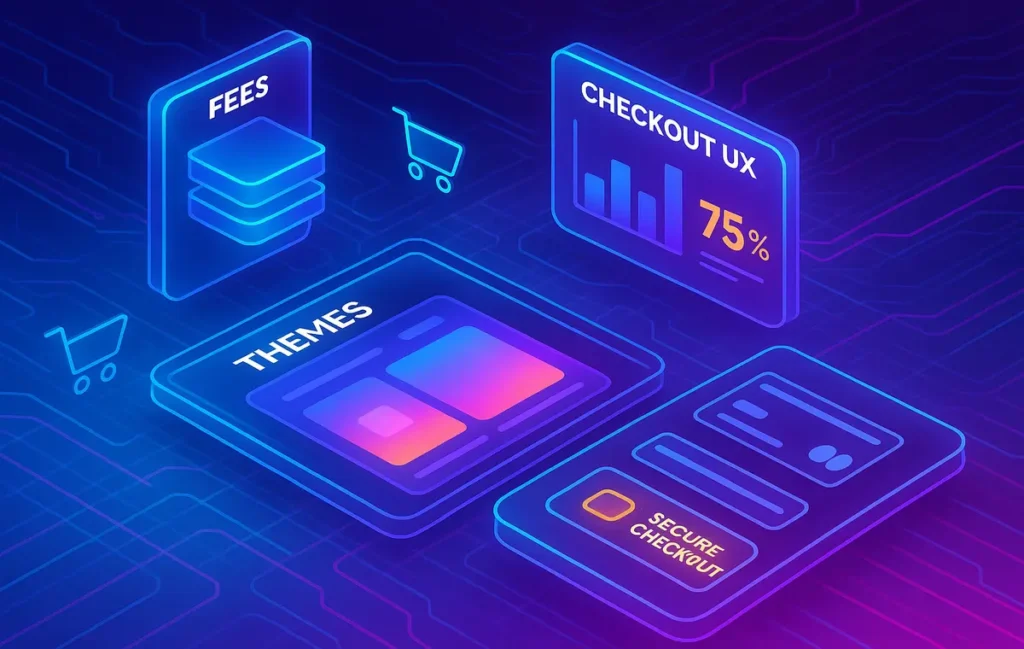🔥 Introduction: Shopify’s Crown and Its Challenges
For over a decade, Shopify has been considered the king of e-commerce platforms. With millions of stores across the globe, it powers everything from small boutique shops to high-growth DTC brands. Its strength lies in usability, scalability, and an unmatched ecosystem of apps and integrations.
But 2025 is not 2015. Competitors like WooCommerce, Wix, and BigCommerce are closing the gap, and Shopify faces increasing scrutiny over pricing, hidden fees, and the complexity of its ecosystem. The question for entrepreneurs is no longer “Can Shopify power my store?” but “Is Shopify still worth the cost in 2025?”
💡 Nerd Tip: Don’t get blinded by Shopify’s popularity. Look closely at fees, customization, and checkout before committing.
📘 Shopify at a Glance (2025 Update)
Shopify continues to lead the pack, but it’s evolving. In 2025, the platform has focused heavily on checkout optimization and expanding multi-channel selling. Express checkout options like Apple Pay and Google Pay are now deeply integrated, and Shopify Payments has expanded to more regions.
The Shopify App Store has crossed 10,000+ apps, covering everything from SEO optimization to AI-driven product recommendations. For founders leveraging automation, integrations with tools like email automation for Shopify store owners are now more seamless than ever.
Mobile performance has also been prioritized. With over 65% of e-commerce transactions happening on mobile, Shopify themes now adopt responsive-first design by default.
💵 Fees & Pricing
Pricing has always been Shopify’s double-edged sword. On the surface, the subscription tiers—Basic, Shopify, and Advanced—seem straightforward, starting around $39/month for the entry plan and scaling upward for additional features.
However, transaction fees complicate the story. Stores using Shopify Payments benefit from lower rates, but if you use third-party gateways like PayPal or Stripe, Shopify adds an extra transaction fee. This often surprises new merchants and can cut into already thin margins.
Then there are hidden costs. Many essential features require apps—ranging from SEO boosters to advanced product filters. While Shopify’s ecosystem is powerful, it can also be expensive. A “$39 plan” can easily balloon to $200/month once apps and add-ons are factored in.
💡 Nerd Tip: Always budget beyond the base fee. Apps and payment fees are the real cost drivers in Shopify.
🎨 Themes & Customization
Shopify’s Theme Store remains a highlight. Free themes are clean and modern, but premium themes (ranging from $180–$350 one-time fees) offer deeper customization. In 2025, premium themes have become more conversion-focused, with features like sticky add-to-cart buttons and mobile-optimized product pages.
Customization has also improved. The drag-and-drop editor allows non-technical founders to build polished storefronts, while developers can dive into Liquid (Shopify’s coding language) for full control. This balance makes Shopify flexible for both beginners and advanced users.
Responsiveness is now standard. Whether on a large desktop or a small mobile device, Shopify themes adapt seamlessly. Given that mobile dominates e-commerce traffic, this is more than a feature—it’s survival.
💡 Nerd Tip: Invest in a premium theme early if your store depends on branding. It pays back quickly in higher conversions.
💳 Checkout UX
Checkout has always been Shopify’s crown jewel, and in 2025, it’s even sharper. The process is now streamlined to reduce clicks and friction. One-page checkout consolidates steps, and express pay options like Apple Pay, Google Pay, and Shop Pay are prominently integrated.
This matters because checkout abandonment remains a plague in e-commerce. Shopify’s checkout is optimized with conversion psychology in mind—clear progress indicators, trust badges, and stored payment details for returning customers. According to Shopify’s internal benchmarks, stores using Shop Pay see an average conversion lift of 18–20%.
The deep integration with Shopify Payments further reduces checkout friction. For global sellers, multiple currencies and localized payment options ensure fewer barriers to completing a purchase.
💡 Nerd Tip: Never underestimate checkout UX. Even a 1% lift in conversion can mean thousands in additional revenue.
🧩 Other Key Features Worth Noting
Shopify’s app ecosystem is one of its defining advantages. Whether you want to add subscriptions, loyalty programs, or advanced analytics, there’s likely an app for it. But this convenience ties back to hidden costs, as many of the most powerful apps charge recurring fees.
SEO and marketing features have improved. Shopify now includes more native SEO customization, but serious marketers often supplement it with specialized apps or even affordable SEO tools for keyword tracking in 2025.
Multi-channel selling is another strength. Shopify allows merchants to sell directly on Instagram, TikTok, Amazon, and even offline via POS systems. For businesses scaling beyond a single storefront, this unified management is invaluable.
💡 Nerd Tip: Shopify isn’t just a store—it’s an ecosystem. Success depends on how well you leverage its integrations.
⚔️ Competitor Comparison (2025 Edition)
In 2025, Shopify isn’t without rivals:
-
Shopify vs WooCommerce: WooCommerce is cheaper upfront (WordPress plugin + hosting), but requires more technical setup. Shopify wins in ease of use, while WooCommerce offers flexibility for those comfortable with customization.
-
Shopify vs Wix / Squarespace: Wix and Squarespace are cheaper and easier for beginners but lack the depth of Shopify’s e-commerce ecosystem. They work for hobbyists but struggle at scale.
-
Shopify vs BigCommerce: BigCommerce competes directly, offering similar pricing but fewer hidden app costs. However, Shopify’s theme ecosystem and checkout UX still give it the edge.
💡 Nerd Tip: Pick Shopify if growth and scalability matter. Pick cheaper alternatives only if your store will stay small.
📈 Pros & Cons of Shopify
Pros
-
Best-in-class checkout UX with conversion boosts
-
Huge ecosystem of apps and integrations
-
Mobile-first responsive themes
-
Scalable for small stores and enterprise brands
Cons
-
Expensive once apps and transaction fees are factored in
-
Reliance on Shopify Payments to avoid extra fees
-
Customization beyond basics often requires coding or premium themes
-
App overload can overwhelm beginners
📖 Case Study: A Small Store That Grew with Shopify
A family-owned jewelry store migrated from Wix to Shopify in 2023. Initially hesitant about the higher costs, they were won over by Shopify’s checkout and app integrations. By 2024, they had integrated 10 best AI marketing tools for small businesses to personalize recommendations and email automation for Shopify store owners to recover abandoned carts.
The result? A 37% increase in revenue within one year. Customers praised the seamless checkout and mobile experience, and the founders admitted: “Yes, Shopify costs more, but we finally feel like we’re running a professional store, not just a website.”
💡 Nerd Tip: Case studies consistently show the same pattern—Shopify costs more upfront but pays back in growth.
⚡ Test Shopify for Free
Curious if Shopify is right for your business? Start a free trial and see how its checkout and themes compare to other builders.
🚀 Performance & Speed Benchmarks
Speed is the silent killer—or savior—of e-commerce. Shopify has invested heavily in performance optimization, and in 2025, most of its themes are fully optimized for Google’s Core Web Vitals. Independent benchmarks show Shopify stores loading in under 2.5 seconds on average, provided merchants don’t overload their sites with too many third-party apps.
This speed matters because conversion rates drop by roughly 7% for every second of delay. In other words, a store that takes four seconds to load instead of two could lose hundreds or thousands in monthly revenue. Shopify’s global CDN infrastructure, combined with built-in image optimization and lazy loading, helps merchants stay competitive without hiring developers for custom fixes.
💡 Nerd Tip: Monitor your store’s Core Web Vitals regularly. Shopify’s foundation is strong, but adding heavy apps and oversized images can undo its speed advantage.
🔒 Security & Compliance
Security is non-negotiable in e-commerce, and Shopify handles much of it behind the scenes. Every store comes with SSL certificates pre-installed, ensuring encrypted transactions and customer trust. PCI DSS compliance—essential for handling credit card payments—is also baked into the platform, which means merchants don’t have to manage complex compliance checklists themselves.
Fraud analysis is another layer Shopify has added, especially for merchants using Shopify Payments. Suspicious transactions are flagged, helping prevent chargebacks. For new store owners unfamiliar with the risks of online payments, this “security by default” is a major relief.
💡 Nerd Tip: While Shopify covers core compliance, merchants should still adopt good practices like two-factor authentication and limiting staff permissions.
📈 Scalability & Enterprise Layer (Shopify Plus)
Shopify is not just for beginners. As businesses grow, Shopify Plus offers advanced capabilities designed for high-volume merchants. With Shopify Plus, brands get customizable checkout experiences, deeper API access for integrating with ERPs and CRMs, and dedicated account managers for support.
This matters because scaling businesses often outgrow standard e-commerce platforms. Features like multi-store management, advanced automation workflows, and wholesale channel support allow enterprise brands to stay on Shopify instead of migrating elsewhere. Companies like Gymshark and Allbirds scaled globally without leaving Shopify—proof that the platform is built to handle enterprise demands.
💡 Nerd Tip: If you anticipate rapid growth, consider Shopify Plus early. Migrating mid-growth can create friction and lost revenue.
🌐 Community & Ecosystem
One reason Shopify continues to dominate is its ecosystem. Beyond the 10,000+ apps in the Shopify App Store, there’s a thriving community of developers, designers, and educators building resources for merchants.
This ecosystem lowers barriers for new entrepreneurs. Need a custom theme? Thousands of freelancers and agencies specialize in Shopify. Want to optimize conversions? Dozens of CRO experts focus exclusively on Shopify checkout flows. Unlike niche platforms, Shopify’s community ensures you’re never left searching for support or tutorials.
💡 Nerd Tip: Tap into the community early. Forums, groups, and agencies can accelerate learning curves and prevent costly trial-and-error mistakes.
⚠️ Hidden Pain Points
No platform is perfect, and Shopify has its drawbacks. Vendor lock-in is a real issue: once your store grows within Shopify’s ecosystem, migrating to another platform is difficult and costly. Transaction fees for third-party gateways remain a sore point, especially in countries where Shopify Payments isn’t available.
Another hidden pain point is app overload. With so many features delegated to third-party apps, stores can become bloated and expensive to maintain. Each app adds cost, potential performance drag, and another point of failure. Some merchants complain that they spend more time managing apps than running their business.
💡 Nerd Tip: Audit your app stack quarterly. Keep only what adds measurable ROI, and consolidate whenever possible.
🔮 Future Outlook: AI & Automation in Shopify
The future of Shopify is AI-driven. In 2025, the platform is already experimenting with personalized product recommendations powered by machine learning. Checkout flows are adapting in real time, suggesting the fastest payment option based on customer behavior.
Shopify’s roadmap also points to more AI integrations with marketing and store management. Imagine an AI tool that auto-generates product descriptions, clusters SEO keywords, or manages inventory forecasts. For founders using 10 best AI marketing tools for small businesses, Shopify is becoming the natural hub where those tools integrate seamlessly.
This evolution is aligned with where e-commerce is heading: automation that frees founders from repetitive tasks so they can focus on strategy and customer experience.
💡 Nerd Tip: Don’t just adopt Shopify for what it is today—look at how it’s positioning for the AI-powered future of e-commerce.
📬 Want More Smart E-Commerce Reviews Like This?
Join our free newsletter and get weekly insights on store builders, marketing tools, and conversion strategies—straight to your inbox.
🔐 100% privacy. No noise. Just actionable growth insights from NerdChips.
🧠 Nerd Verdict
Shopify in 2025 remains a powerhouse. Its checkout UX is still unmatched, themes are polished, and the app ecosystem ensures scalability. But costs creep up fast, especially for SMBs relying heavily on apps and third-party gateways.
At NerdChips, we see Shopify as the best choice for serious e-commerce entrepreneurs. If you’re testing the waters, cheaper platforms may suffice. But if growth and conversion rates are your top priority, Shopify remains the king—hidden fees and all.
❓ Nerds Ask, We Answer
💬 Would You Bite?
If Shopify’s fees cut into 2% of your revenue but doubled your conversions, would you still use it—or look for cheaper alternatives?
Crafted by NerdChips for founders and teams who want to build stores that convert.



